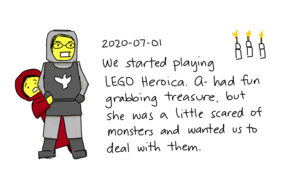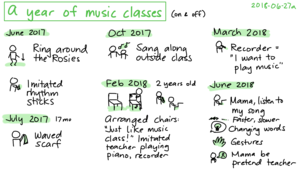Expanding our pretend play with roleplaying games
Posted: - Modified: | parenting, playWhen we reorganized our living room to bring more things down to A-‘s level, W- thought of bringing the LEGO Heroica games down even though the boxes said 8+ years old. A- noticed them, of course. We built the different game elements and started playing. At first, she was too anxious to go near monsters. Her voice quavered and she made amusing attempts to distract us from the game. We said she could pick the wizard, hide behind our characters, use her ranged attack whenever the opportunity came up, and dash in to grab the treasure. She did so gleefully.
She eventually worked up the courage to deal with monsters with 1 strength, and then 2 strength, and even the occasional 3-strength final boss. She mixed in elements from other LEGO sets and invented her own rules, like letting cupcakes and cookies restore 1 health point. In pretend play, she fluidly shifted between being a golem, a goblin, and a wizard. We made up stories about a LEGO Friends cupcake cafe owner making friends with goblins by giving them free samples. She mixed game terms into everyday life: “I rolled shield!” She played with words like ranger and ranged. We took turns reading the comics and the manuals, and she had plenty of questions.
W- was curious about whether A- was ready for other roleplaying games, so he printed out Monster Slayers: The Heroes of Hesiod and The Champions of the Elements. I acted as the dungeon master, she played the wizard, and I played the fighter as well. We used the Heroica figures instead of the paper hero tokens, and we used LEGO cones for health points instead of shading in circles. She got the hang of rolling the dice and taking off the monsters' health points whenever she landed an attack. (I did the math for her.) It was lots of fun.
I wonder if I can enrich our pretend play to expand her world knowledge, help her practise solving problems, and maybe even motivate mark-making. We've been doing a bit of pretending with our improvised version of the LEGO Friends Lighthouse Rescue Center. I've shown her a few videos of veterinarians working in rescue centres, including one of a fish getting a prosthetic eye. She pretended to rescue some LEGO animals we had. I asked her to draw diagrams of where the animals were injured, come up with names for them, and write down the first letters of their names and the first letter of her name.
Amazing Tales released 2-page quickstart rules and lots of adventures for free. I might be able to adapt A Very Rainy Day to a wildlife rescue scenario. Hmmm…


